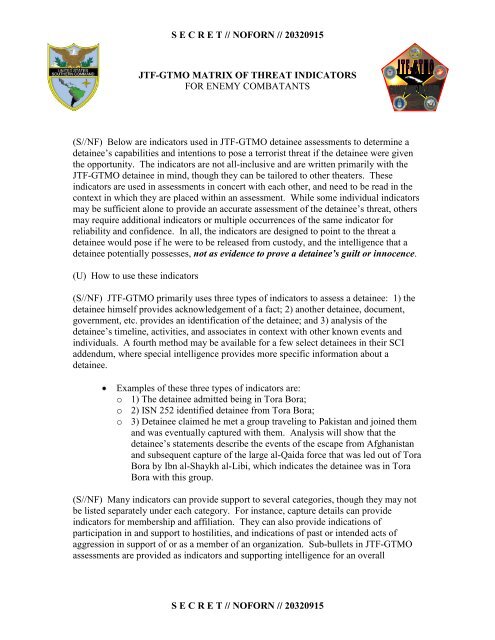linked - Investigating the Terror
linked - Investigating the Terror
linked - Investigating the Terror
Create successful ePaper yourself
Turn your PDF publications into a flip-book with our unique Google optimized e-Paper software.
S E C R E T // NOFORN // 20320915<br />
JTF-GTMO MATRIX OF THREAT INDICATORS<br />
FOR ENEMY COMBATANTS<br />
(S//NF) Below are indicators used in JTF-GTMO detainee assessments to determine a<br />
detainee‟s capabilities and intentions to pose a terrorist threat if <strong>the</strong> detainee were given<br />
<strong>the</strong> opportunity. The indicators are not all-inclusive and are written primarily with <strong>the</strong><br />
JTF-GTMO detainee in mind, though <strong>the</strong>y can be tailored to o<strong>the</strong>r <strong>the</strong>aters. These<br />
indicators are used in assessments in concert with each o<strong>the</strong>r, and need to be read in <strong>the</strong><br />
context in which <strong>the</strong>y are placed within an assessment. While some individual indicators<br />
may be sufficient alone to provide an accurate assessment of <strong>the</strong> detainee‟s threat, o<strong>the</strong>rs<br />
may require additional indicators or multiple occurrences of <strong>the</strong> same indicator for<br />
reliability and confidence. In all, <strong>the</strong> indicators are designed to point to <strong>the</strong> threat a<br />
detainee would pose if he were to be released from custody, and <strong>the</strong> intelligence that a<br />
detainee potentially possesses, not as evidence to prove a detainee’s guilt or innocence.<br />
(U) How to use <strong>the</strong>se indicators<br />
(S//NF) JTF-GTMO primarily uses three types of indicators to assess a detainee: 1) <strong>the</strong><br />
detainee himself provides acknowledgement of a fact; 2) ano<strong>the</strong>r detainee, document,<br />
government, etc. provides an identification of <strong>the</strong> detainee; and 3) analysis of <strong>the</strong><br />
detainee‟s timeline, activities, and associates in context with o<strong>the</strong>r known events and<br />
individuals. A fourth method may be available for a few select detainees in <strong>the</strong>ir SCI<br />
addendum, where special intelligence provides more specific information about a<br />
detainee.<br />
Examples of <strong>the</strong>se three types of indicators are:<br />
o 1) The detainee admitted being in Tora Bora;<br />
o 2) ISN 252 identified detainee from Tora Bora;<br />
o 3) Detainee claimed he met a group traveling to Pakistan and joined <strong>the</strong>m<br />
and was eventually captured with <strong>the</strong>m. Analysis will show that <strong>the</strong><br />
detainee‟s statements describe <strong>the</strong> events of <strong>the</strong> escape from Afghanistan<br />
and subsequent capture of <strong>the</strong> large al-Qaida force that was led out of Tora<br />
Bora by Ibn al-Shaykh al-Libi, which indicates <strong>the</strong> detainee was in Tora<br />
Bora with this group.<br />
(S//NF) Many indicators can provide support to several categories, though <strong>the</strong>y may not<br />
be listed separately under each category. For instance, capture details can provide<br />
indicators for membership and affiliation. They can also provide indications of<br />
participation in and support to hostilities, and indications of past or intended acts of<br />
aggression in support of or as a member of an organization. Sub-bullets in JTF-GTMO<br />
assessments are provided as indicators and supporting intelligence for an overall<br />
S E C R E T // NOFORN // 20320915


